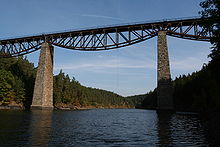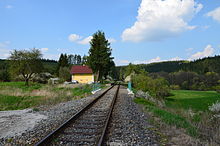Railway line Pňovany – Bezdružice
| Pňovany – Bezdružice | |||||||||||||||||||||||||||||||||||||||||||||||||||||||||
|---|---|---|---|---|---|---|---|---|---|---|---|---|---|---|---|---|---|---|---|---|---|---|---|---|---|---|---|---|---|---|---|---|---|---|---|---|---|---|---|---|---|---|---|---|---|---|---|---|---|---|---|---|---|---|---|---|---|
| Course book series (SŽDC) : | 177 | ||||||||||||||||||||||||||||||||||||||||||||||||||||||||
| Route length: | 23.961 km | ||||||||||||||||||||||||||||||||||||||||||||||||||||||||
| Gauge : | 1435 mm ( standard gauge ) | ||||||||||||||||||||||||||||||||||||||||||||||||||||||||
| Route class : | C2 | ||||||||||||||||||||||||||||||||||||||||||||||||||||||||
| Maximum slope : | 26 ‰ | ||||||||||||||||||||||||||||||||||||||||||||||||||||||||
| Minimum radius : | 190 m | ||||||||||||||||||||||||||||||||||||||||||||||||||||||||
| Top speed: | 60 km / h | ||||||||||||||||||||||||||||||||||||||||||||||||||||||||
|
|||||||||||||||||||||||||||||||||||||||||||||||||||||||||
The Pňovany – Bezdružice railway line is a railway connection in the Czech Republic that was originally built and operated as a state-guaranteed local railway Neuhof – Weseritz (Czech: Místní dráha Nový Dvůr – Bezdružice ). It branches off in Pňovany (formerly Nový Dvůr / Neuhof ) from the Plzeň – Cheb railway line and leads via Konstantinovy Lázně ( Konstantinsbad ) to Bezdružice ( Weseritz ).
According to a decree of the Czech government, the line has been classified as a regional railway ("regionální dráha") since December 20, 1995.
history
The concession for a "local train from the Neuhof station of the state railway line Pilsen-Eger to Weseritz" was given to Prince zu Löwenstein-Wertheim-Rosenberg , ruler in Haid, together with August Graf Wydenbruck, ruler in Topiat, Joseph Starck, Attorney in Pilsen, and Wenzel Guschal, district chairman in Weseritz, granted. The concessionaires were obliged to start construction of the lines immediately and to finish them within two years. The duration of the concession was set at 90 years.
The line was opened on June 2, 1901. The operation was carried out by the kk Staatsbahnen (kkStB) on behalf of the owners. In 1912 the timetable of the local railway indicated three mixed pairs of 2nd and 3rd class trains. They needed about an hour and a half for the 24-kilometer route.

After the collapse of Austria-Hungary in October 1918, management was transferred to the newly founded Czechoslovak State Railways (ČSD) . On January 1, 1925, the Neuhof – Weseritz local railway was nationalized and the line was integrated into the ČSD network. From then on, it was administered by the State Railway Directorate (Ředitelství státních drah) in Plzeň.
The commissioning of modern motor trains by the ČSD at the end of the 1920s enabled both a significant consolidation of the timetable and a reduction in travel times to just 48–53 minutes. The ČSD established new stops in Lomnička and Břetislav . The winter timetable of 1937/38 recorded five pairs of 3rd class passenger trains, all of which were run as motorized trains.
After the Sudetenland was annexed to Germany in autumn 1938, the line came to the Deutsche Reichsbahn , Reichsbahndirektion Regensburg . The connection was now included in the imperial course book as the course book route “422h Neuhof (b Mies) –Weseritz”. On May 9, 1945, the entire line came back to the ČSD.
On January 1, 1993, the line was transferred to the newly founded České dráhy (ČD) in the course of the dissolution of Czechoslovakia . Since 2003 it has been part of the network of the state infrastructure operator Správa železniční dopravní cesty (SŽDC) .
In the 2013 annual timetable, the route will be served by passenger trains every approximately two hours. In addition, the trains are tied to and from Plzeň hlavní nádraží , with the exception of the first train in the morning, which only runs as a train pair between Pňovany and Bezdružice . Freight traffic only takes place between Pňovany and Cebiv .
The bridge over the Hracholusky dam has been renewed since summer 2018 , for which the route was closed since July 23, 2018. The masonry pillars were renovated and new steel superstructures installed for a total of 109 million crowns. A new type of technology was used, in which the new superstructures were pushed onto the old superstructures lying on the side of the road and then rotated with them around their own axis into the installation position. The old superstructures could then be transported over the completed bridge in the same way and scrapped on site. The endurance test of the bridge on April 27, 2019 with three locomotives of the ČD class 781 with a total mass of 348 tons was spectacular . The train service was resumed on April 30, 2019.
Route description
course
The Pňovany – Bezdružice line has its starting point at the Pňovany station on the Plzeň – Cheb line, which it leaves in a westerly direction. After a short descent, it crosses the Mže ( Mies ) river on a high fish-belly girder bridge, which is dammed here by the Hracholusky dam . The further route leads in a north-westerly direction through the Stříbrská pahorkatina , whereby only small, insignificant villages are touched. The route ends in the small town of Bezdružice. The most important stop in tourist traffic is the Konstantinovy Lázně spa stop.
Operating points
Pňovany
The Pňovany railway station has existed since January 28, 1872. Originally it was named after the small settlement Neuhof / Nový Dvůr , but it was not until 1961 that it was given its current name. The current reception building dates from 1900, the original from 1871 was demolished in 2007. Between 2006 and 2008, the station was given its current appearance as part of the complex renewal of the route between Plzeň and Cheb. Since then, the trains to Bezdružice have started on a separate island platform, which can be reached through a newly built platform tunnel.
Blahousty
Today's Blahousty stop was opened in 1901 as the Malowitz stop. In addition to the continuous main track, there was originally also a loading track. It was dismantled around 1978.
Trpísty
In the past, the Trpísty stop was one of those stops with a greater volume of goods traffic. Until 1982, there was a grain store at the loading track, which was originally built by the Mies rural cooperative. In 1980, the Úněšov State Estate built a warehouse for fertilizers on a short siding. Until the 1970s, the loading line was also used for loading raw wood.
Lomnička
The Lomnička stop was opened on October 6, 1931. The systems consist only of the platform and a simple sheet metal waiting hall.
Cebiv
Today, Cebiv station is the last stop on the route with regular freight traffic. In particular, logs are handled at the loading ramp of a timber warehouse. The reception building of the station was completely renovated in 2006. The neighboring, unused wooden goods shed, however, was demolished in 1999.
Strahov
The Strahov stop is far outside of the place that gives it its name. It is of particular tourist importance as the starting point for some hiking trails. The exterior of the small reception building was repaired in 2008.
Břetislav
The Břetislav stop was opened on October 5, 1930. The systems consist only of the platform and a simple sheet metal waiting hall.
Kokašice
The present Kokašice station was the station of the Konstantinovy Lázně spa until 1905. The station's facilities consist only of the main track and a loading track that is integrated with switches on both sides. In autumn 2005 the reception building was completely renovated. The wooden waiting hall for the spa guests, which had been in place until then, but had not been used for a long time, also disappeared. Kokašice is a demand stop due to the low number of travelers.
Konstantinovy Lázně
The Konstantinovy Lázně stop was established in 1905. In the first years of operation, tickets were sold in the nearby Hotel Alžbětin dvůr. A wooden extension served as a waiting room. The station building, which is still in use today, was inaugurated on April 4, 1962.
Bezdružice
Bezdružice train station is the end of the line. The three-track station system consists of platform, transfer and loading track. The three-tier locomotive shed used to house the locomotives of the local railway. Today it is used to park historical vehicles. The T 211.0814 diesel locomotive has been erected as a memorial at the station building.
The Bezdružice train station is now only used for tourist traffic. Scheduled freight traffic no longer exists since 1995.
| 1913 | 1921 | 1939 | 1946 | 2013 |
| Neuhof | Nový Dvůr / Neuhof | Neuhof (b Mies) | Nový Dvůr u Stříbra | Pňovany |
| Mallowitz-Blahussen H. | Malovice-Blahousty / Mallowitz-Blahussen | Mallowitz-Blahussen | Blahousty | Blahousty |
| Trpist | Trpisty / Trpist | Trpist | Trpísty | Trpísty |
| - | - | Lamichka | Lomnička | Lomnička |
| Zebau | Čebiv / Zebau | Zebau | Cebiv | Cebiv |
| Strahof H | Strahov / Strahof | Strahof | Strahov | Strahov |
| - | - | Setzlaw | Břetislav | Břetislav |
| Constantinsbad | Lázně Konstantinovy / Konstantinsbad | Kokaschitz | Kokašice | Kokašice |
| Constantinsbad H | Lázně Konstantinovy z. / Constantine bath H | Constantine Bath | Konstantinovy Lázně | Konstantinovy Lázně |
| Weseritz | Bezdružice / Weseritz | Weseritz | Bezdružice | Bezdružice |
Vehicle use

For the account of the local railway Neuhof – Weseritz the kkStB acquired two of the proven local railway locomotives of the 97 series (ČSD 310.0). The two locomotives had the road numbers 97.190 and 191.
In the early 1930s, travel was taken over by the then modern Tatra tower cars . After 1945 they were replaced by the ČSD class M 131.1 railcars . Since 1983, railcars of the ČSD series M 152.0 (today: 810) have been in use. Today all passenger trains are driven by ČD class 814 “Regionova” railcars .
Web links
- Pňovany – Bezdružice on www.zelpage.cz
- Description of the route (Czech, partly also German)
Individual evidence
- ↑ Zdeněk Hudec u. a .: Atlas drah České republiky 2006–2007 , 2nd edition; Publishing house Pavel Malkus, Praha, 2006, ISBN 80-87047-00-1
- ↑ Decree of the Czech government of December 20, 1995
- ↑ Imperial Law for the Kingdoms and Countries represented in the Imperial Council No. 193/96 - Issued on October 27, 1896
- ↑ 1912 timetable of the kkStB - valid from May 1, 1912
- ↑ http://www.psp.cz/eknih/1920ns/ps/tisky/t5205_01.htm
- ↑ ČSD winter timetable 1937/38 - valid from October 3, 1937
- ^ Deutsches Kursbuch - Annual timetable 1944/45, valid from July 3, 1944 until further notice
- ↑ "Nad hladinou nádrže Hracholusky je první nový oblouk železničního mostu" on zdopravy.cz
- ↑ “Obrazem: 348 do najednou. Tři sergeje prověřily most přes Hracholusky ”on zelpage.cz
- ^ Description of the Pňovany railway station on www.bezdruzickalokalka.cz
- ↑ Description of the Blahousty stop on www.bezdruzickalokalka.cz
- ↑ Description of the Trpísty stop on www.bezdruzickalokalka.cz
- ↑ Description of the Lomnička stop on www.bezdruzickalokalka.cz
- ↑ Description of the Cebiv train station on www.bezdruzickalokalka.cz
- ↑ Description of the Strahov stop on www.bezdruzickalokalka.cz
- ↑ Description of the Břetislav stop on www.bezdruzickalokalka.cz
- ^ Description of the Kokašice train station on www.bezdruzickalokalka.cz
- ^ Description of the Konstantinovy Lázně station on www.bezdruzickalokalka.cz
- ↑ Description of the Bezdružice train station on www.bezdruzickalokalka.cz
- ↑ Artaria railway map of Austria-Hungary and the Balkans , with Station Directory; Artaria & Co., Vienna 1913
- ↑ Summer timetable 1939 of the DR - valid May 15 to October 7, 1939
- ↑ Current ČD timetable ( Memento of October 9, 2006 in the Internet Archive ) (PDF; 133 kB)
- ↑ Directory of the locomotives, tenders, water cars and railcars of the kk Austrian state railways and the state operated private railways as of June 30, 1917. Verlag der kk Österreichische Staatsbahnen, Vienna 1918.




